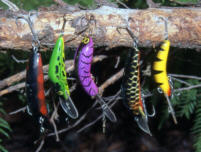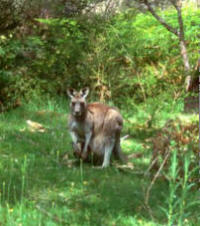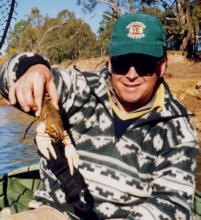The
Murray River stretches across some 2600 kilometers and 3 states
being Victoria, New South Wales and South Australia. The river
boasts fauna and flora that keeps the nature lovers coming back
and is renowned as one of the better fishing destinations for
the travelling angler.
The main artery of the Murray is what most people are familiar
with and are prepared to travel miles during the holiday periods
to enjoy the many water sports this large river has to offer.
Caravan parks and campgrounds are scattered along the length
of this great river, which offer a close base camp to some fantastic
angling for the native fish that inhabit the mighty Murray.
Some caravan parks offer fantastic facilities and other campgrounds
are bush camping so all rubbish should be taken out with you
when you leave. The river has many steep banks so camping and
small boat launching is most comfortable wherever you can get
low to the water like a sandy beach on a bend.
The caravan parks offer camping from unpowered tent sites to
5 star villas and most have steep concrete boat ramps to accommodate
the larger vessels. The river also has many flora and fauna
parks that often include special 'no ski zones' to ensure a
peaceful environment for photographers, bushwalkers, bird watchers
and fishermen.
The Murray River is home to many species of poisonous snakes
so it is best to check with the locals for advice on how to
avoid these reptiles when bushwalking.
Primary fishing targets include the famous Murray cod, golden
perch, silver perch, catfish, redfin and carp (all species of
carp are deemed 'noxious species' and should not be returned
to the water).
|
The
hard fighting silver perch are becoming a little harder
to find in the Murray River these days. They are more
often than not caught on baits and are not well known
for their affinity with lures, but ever now and then they
surprise a lucky angler.
|
 |
Click
on image for larger version
The
river is also home to some of the world's largest freshwater
crayfish that can approach 2 kilograms and are a popular target
in the cooler months from May to September. 'Crays' as they
are known locally, can be caught using a hoop net baited with
fatty meat in the deeper sections of the river where there is
ample cover. These crustaceans are a known delicacy and the
river can be dotted with hoop net floats when the crays are
on the move.
|
This
undersized Murray cray means business! It's a good idea
to keep well clear of their claws should you catch one.
This one refused to let got of my camera bag until he
felt water on his legs as he was lowered into the river.
Their outer shell is also covered in very sharp spines
and gloves are a handy addition to the tackle kit when
targeting these delicious crustaceans.
|
|
Click
on image for larger version
The
other smaller species of freshwater crayfish that inhabits the
Murray are known as 'yabbies' and can be caught in numbers using
basically the same method. On rare occasions, yabbies can reach
'beer bottle length' (30cm), but your typical edible size is
around the 10 to 20cm mark. These delicious crustaceans are
best targeted in slow moving backwaters and during the warmer
months from November to April.
But
it is the population of native fish that draws people from near
and far - and rightly so. Murray cod have been recorded to a
staggering 113kg and 1.8m and each year the river yields a monster
or two over the magical 1m mark!
Most of these leviathans are returned to the water, as they
are the larger 'breeders' of the river. There are strict guidelines
and a fishing license is required for fishing in the Murray/Darling
Basin so please check local fishing guides and tackle stores
before the big trip.
The
river is best fished using a boat but land-based anglers grass
many fish and this is a very relaxing method of targeting the
Murray's inhabitants. Land-based fishermen are better off using
either running sinker rigs when bait fishing, surface lures
(after dark) or spinnerbaits when lure fishing to avoid their
hooks fouling and high lure losses due to the many snags the
native fish call home.
Best baits are the form of the local shrimp population, small
yabbies and a large moth pupa known as the 'bardi grub' (note:
it is illegal to use fin fish for bait in the Murray River).
Murray cod find these grubs irresistible and these baits can
reach 15cm in length. They can be found burrowing in the earth
under the overhanging branches of certain gum trees or purchased
from reputable tackle stores.
When boat-based, you can open up your options a little more
by way of positioning yourself over underwater snags that would
otherwise see you snagged up solid if you cast to it from the
bank. This allows you to lower your tasty morsel down to the
most likely looking underwater obstacle using a depth sounder.
Best bait rig for the boat-based angler is a round sinker running
straight to the eye of the hook. It's best to keep rigs simple,
as the loss of terminal tackle can be high.
Alternatively, a popular way to target native fish is by trolling
lures along the deeper sections of the Murray River. Lures designed
with Murray cod in mind are generally large (around 70 to 150mm
in length) and can obtain depths from 4 - 8m when trolled behind
a boat.
 |
Don't
be shy with lure sizes. Here a 55cm cod has slammed a
No1 Stumpjumper intended for his grandad.
|
Click
on image for larger version
Their
action is generally a wide sway. This allows for the lure to
be used very slowly and to tantalisingly hang in the fish's
face, so to speak, for longer.
|
Here
is a good spread of cod lures that cover the deeper sections
of the river where the "meter-plus" fish live.
They are (left to right) T50 Flatfish (dives to around
4.5m); Legend lures Yarrum (5-6m approx), Goulburn Codger
(5-6m approx), JJ's No1. Stumpjumper (6-8m approx) and
the Swagman Jumbuck (7-8m)
|
 |
Click
on image for larger version
Using
these large, deep diving lures is the most effective way to
target the larger cod, as they tend to hang in the deeper sections
of the river.
By far the most enjoyable way to target native fish is to cast
lures around the many fallen trees along the banks of the river.
Some of these trees exceed 1.5m in diameter and are an absolute
haven for all forms of aquatic life. When casting, yet another
option is opened up that is not previously available to those
trolling lures - and that is the fact that you can 'annoy' the
fish into a strike by repeatedly retrieving the lure past their
hole. Most Australian native fish are extremely territorial
and will chase a potential intruder off with vigour. Their aggression
is often their downfall and you can often feel multiple strikes
or 'bumps' while casting at the same snag before a hook-up.
Golden perch are the other main target of anglers who visit
the Murray. These fish posses an incredible spawning urge at
certain times of the year and have been tracked for more than
6000km when the urge arises. Golden perch are famous for following
lures repeatedly giving them a nip or a bump to hurry them out
of their territory. If this is happening, vary your retrieval
rate so as to imitate an injured fish. More often than not,
if repetitive casts don't get him, the old 'wounded fish' trick
will!
|
Golden
Perch are another favourite target and are relatively
widespread in the Murray River. Their eating qualities
vary from something akin to muddy mashed potato to one
of the best freshwater eating fish available. Larger specimens
(4lb +) are best returned as they have a high fat content.
This little ripper slammed a spinnerbait slow rolled down
a rocky outcrop.
|
|
Click
on image for larger version
These
fish are also well known for striking at lures that would never
fit in their mouths. This suggests they are an incredibly aggressive
fish. This also makes them a prime candidate for lure casting
at the snags and can be tormented into attacking the artificial
with a few repetitive casts.
Many native animals call the banks of the Murray home and if
you keep the noise to a minimum, you can present yourself with
some good photo opportunities of the local kangaroo, koala and
bird population.
 |
Kangaroos
are very timid and can normally only be seen early morning
coming down to the river for a drink before a hot day. Here
a mum and joey (the baby kangaroo is known as a joey. Its
hind legs can be seen poking out from the mother's pouch
close to her right forearm) enjoy some lush after-flood
greenery before retreating to the safety of the bush. |
Neil
Slater
Related
Topics:
Murray
River Introduction - Neil Slater









